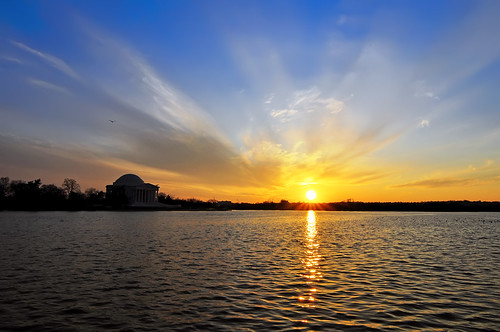Photography is all about light and sometimes it doesn’t cooperate. It’s either the exposure which isn’t right, or the colors that are dull or over-saturated (or both). Even with modern camera technologies, like ADR and built-in color tuning settings, there are times when we can’t just get what we want SOOC. But there are some ways to “cheat”, though. Take a look at the photo above. I think it looks good, with nice colors in the sky and light well-balanced. Even the sun isn’t blowing the highlights. Now, take a look at the photo below:

Similar camera settings (shutter speed a bit faster – 1/640), same place (apart from the bird above Jefferson Memorial), but it looks a bit dull. So, what’s the difference? Answer: filters. And the right ones.
For landscape photography, I really like using color filters and graduated ND filters. Half-color filters allow me to do great things, like making the sky more vivid like this:

This is what the same photo (same camera settings as the previous “raw” image) looks like with a half-blue filter (or half-80) in the upper half of the frame. Another filter I like is the half-orange (or half-81) to warm the tones a bit:

This is what the “raw” image looks like with a half-81 filter applied to the bottom of the frame. The next filter isn’t a color filter, but something used to gain fine control over exposure.
The problem with this shot in particular is that I cannot have a decent exposure on the water without making the sky dark. So my solution here is to correct exposure the sky and use a grad-ND filter on the lower half of the frame. That looks like this:

And finally, when I stack all the filters (and pump the brightness settings a bit), I have this:

Which is the final image you first saw in this page. Stacking filters adds a lot of vignette in a ultra-wide lens, so I had to correct that in Photoshop. But otherwise, this is SOOC.
One important thing to notice is that you don’t actually need color filters in digital cameras. They can be easily faked in Photoshop using the Adjustment Layer/Photo Filter option, plus a gradient layer mask. Graduated ND filters, on the other hand, can’t be digitally emulated easily from a single shot. That’s because blown highlights are lost forever and you can’t really recover the missing bits. So the only way to do this is to shoot two frames with different exposures and then use a gradient layer mask. If you take a lot of sunset/landscape photos and want to buy a good ND-grad, I suggest you to look at the Tiffen 0.6 ND-grad, which is great and I recommend.
